




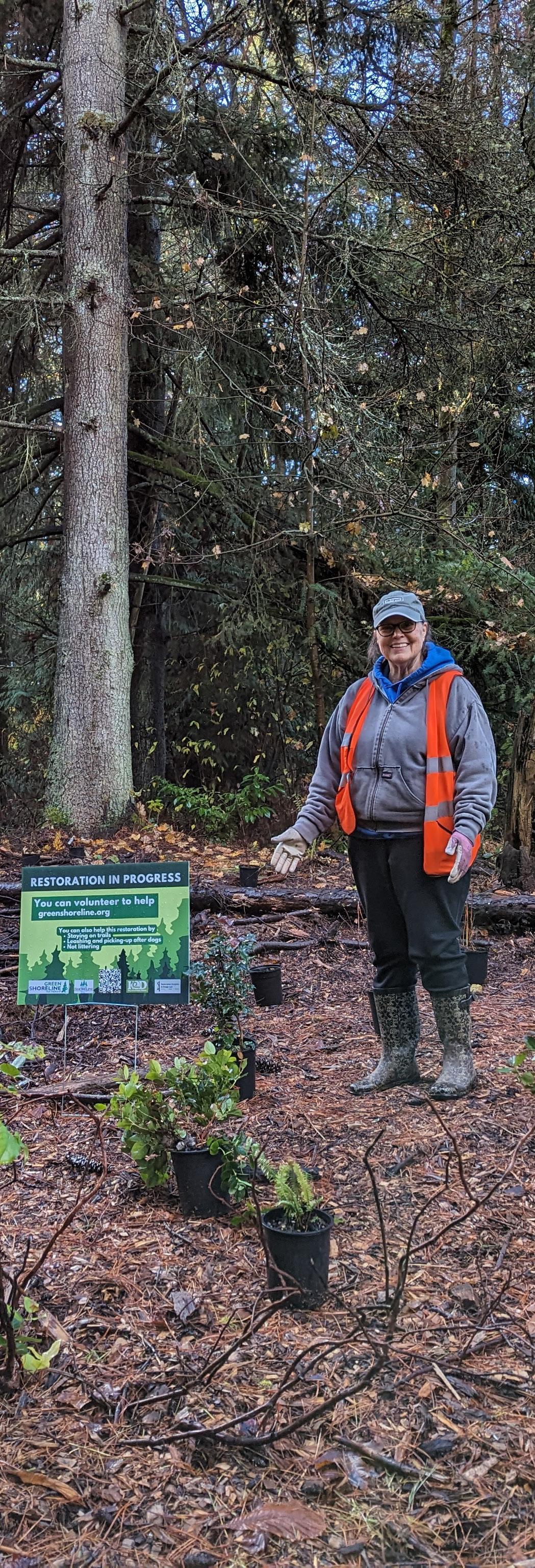
The Shoreline City Council adopted the Climate Action Plan update in December 2022. It identifies ways to quickly and equitably reduce greenhouse gas emissions from Shoreline. It also identifies ways to support healthy ecosystems and increase resilience to climate change impacts. The plan is divided into five focus areas with a total of 90 actions. It prioritizes the most impactful things we can do to achieve net zero emissions by 2050 while supporting our community’s priorities around equity, cost savings, and public and ecosystem health.
2023 was our first full year of putting the plan into action. We used existing City funding with state and local grants to make progress on key actions, including:
• Completing a study to identify key locations for public electric vehicle charging
• Supporting the opening of the Shoreline Tool Library
• Launching a special item recycling program for renters
• Expanding our Communi-trees program
We also developed internal tracking systems and formed an internal Climate Action Team. This team holds all City departments accountable for supporting the Climate Action Plan and ensures they are allocating the necessary staff and resources to meet our targets.
This first Year in Review shows what the City Council, City staff, and the Shoreline community did in 2023 to make progress toward our overall goals to reduce emissions, support ecosystem health, and increase resilience.
Our Climate Action Plan has 90 actions spread across five focus areas to achieve our goals of reducing emissions, enhancing ecosystem health and sequestration, and increasing resilience and preparedness. This page provides a snapshot of the status of each action.
⟶ View a complete list of 2023 progress updates and notes for all 90 actions.
The action has a clear end point and we have reached it!
Either the action involves multiple projects or programs that we have started and are likely to continue for the entire period of the Climate Action Plan, or it has a clear end point and we are currently working on it.





We have not started working on the action.
ransportation & m o B ility (26 actions)
Buildings & e
(18 actions)
Zero Waste (16 actions)
Healthy ecosystems (15 actions)
Community resilien C e (15 actions)

Achieve 30% electric passenger and lightduty vehicles and 1% electric heavy-duty vehicles on the road by 2030
We estimate that 5% of registered passenger, light, and heavy-duty vehicles were electric in 2023.*

Increase electric vehicle charging at multifamily properties by 2030, especially at affordable housing locations
We identified 6 multifamily properties with electric vehicle charging, 4 of which provide affordable housing options.*
Reduce miles driven per person 20% by 2030 and 50% by 2050
We saw a 14% decrease in miles driven per person per day in 2022 compared to our 2019 baseline.†
Replace all light and medium-duty vehicles and off-road equipment in the City fleet with electric alternatives by 2030‡ 23% electric or HyBrid 77% gas or diesel We are working to electrify the rest of our fleet.

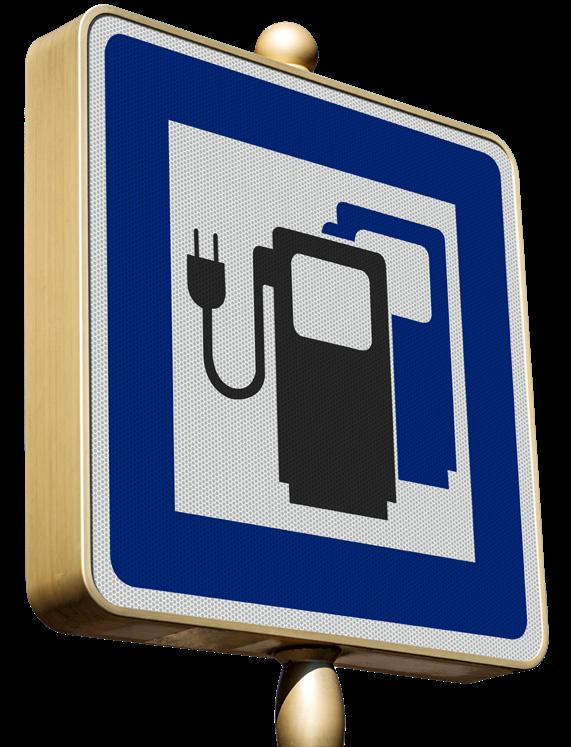
Increase public electric vehicle charging locations added annually, especially in lower income and vulnerable neighborhoods
We identified 8 public electric vehicle charging sites with 26 charging ports.*

Action TM 1.10: Expand transit service and access
We began planning for the changes that will come with the arrival of light rail in 2024. The City Council increased zoning for higher-density housing around the two future stations. This supports development of multifamily housing within walking distance of frequent public transit and businesses. We started making improvements to our transportation infrastructure to make walking, biking, and taking public transit the easy choice for getting around. We also worked with King County Metro and Community Transit to provide direct and frequent access to the light rail stations.
Most of Shoreline’s emissions come from gasolinepowered cars. By investing in infrastructure for walking, biking, and public transit, we are taking important steps to reduce these emissions.
⟶ Learn more about the transportation projects linked to the Shoreline South/148th light rail station.
Action TM 2.6: Install public charging stations in strategic locations
We completed a study to identify key locations to install public electric vehicle (EV) charging stations. Increasing the availability of public charging stations makes it easier for people to switch to EVs. This helps reduce our community’s carbon footprint. The study will help as we explore options for installing accessible, public EV chargers across the city. One of the City's strategies to increase public charging is to focus on filling in the gaps in the charging network for residents who don't have access to at-home charging. This includes looking at options for expanding EV carshare.
Shoreline has access to plentiful, affordable, carbonfree electricity from Seattle City Light. Replacing conventional gasoline and diesel-powered cars with electric options is a key strategy for decarbonizing Shoreline’s transportation.
• Begin construction on the:
• 145th Street Corridor to improve traffic operations, safety, and mobility throughout the corridor
• 148th Non-motorized Bridge to improve safety, reduce travel times, and improve access to regional transit at the future Shoreline South/148th light rail station
Action TM 1.10: Expand transit service and access
• Launch an electric scooter and bike-share pilot program in 2024 to provide flexible, low-carbon options for short trips
Action TM 1.9: Provide shared-use electric bicycle or scooter programs
• Present recommendations for the City Council to update the municipal code to increase available bicycle parking in new development and prepare the City for future demand
Action TM 1.11: Increase bicycle parking infrastructure
• Conduct a shared-use mobility hubs study to support cross-community travel by transit, rideshare, EVs, bike, and scooter
Action TM 1.8: Create mobility hubs
What you C an do
• Reduce how many miles you drive. Take transit, walk, bike, telecommute, or use shared mobility services when possible.
• Use an e-bike for short trips.
• Replace gasoline or diesel-powered vehicles with electric options.
⟶ Learn more about EVs and available tax credits and rebates.

o ur targets
Reduce heating oil usage 100% by 2030
Compared to 2019, the *number of homes using heating oil decreased by 26%
Utilize electricity for space and water heating and cooking in all City facilities by 2030
Increase local solar generation by 2.5MW by 2030 and 6.5MW by 2050
In 2023, we increased our total solar generation from 2019 levels by 3.0mw
Reduce natural gas usage 60% by 2030 and 98% by 2050
Compared to 2019, we saw natural gas usage increase by 7%
Reduce energy consumption 15% by 2030 and 30% by 2050
Compared to 2019, we saw total energy usage increase by 9%

The other 4 use natural gas for one or more heating needs.
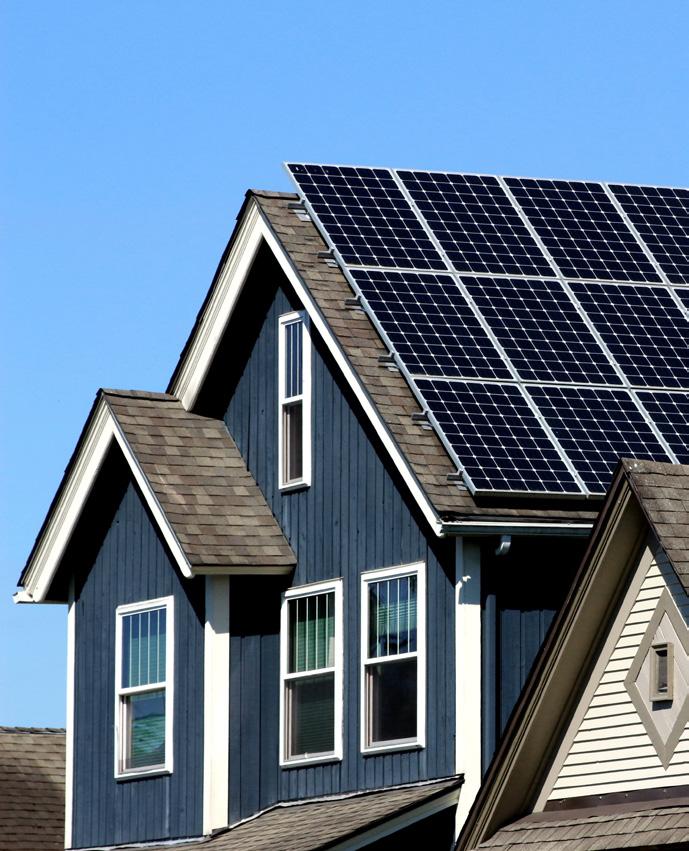
Increase the proportion of new residential buildings pursuing green certification
80% of permitted new residential buildings pursued a green building standard in 2023. This up from 50% in 2020.

Action BE 1.3: Provide a home electrification program
One of the key strategies to reducing Shoreline’s emissions is to switch from using gas and oil to heat our homes to using electricity.
In partnership with the cities of Lake Forest Park and Kenmore, we developed and hosted a three-part educational series about how people can switch to electricity. We talked about heat pumps, induction stoves, and solar panels. Our goal was to help homeowners and renters learn more about switching to electric appliances and heating systems. We also discussed how they can take advantage of federal and local rebates and incentives. Nearly 150 residents attended one or more workshops.
• In the summer of 2024, we will launch Energize Shoreline – a pilot program to educate residents about heat pump technology. We will provide information about available incentives and rebates for homeowners to install heat pumps and make purchasing and installing heat pumps accessible for income-qualified homeowners.
Action BE 1.3: Provide a home electrification program
⟶ Visit ShorelineWA.gov/GoElectric to learn more about electrifying your home.
• We will also propose to the City Council updated commercial energy code requirements for large buildings. This will help make them more energy efficient and reduce emissions.
Action BE 2.2: Support energy efficiency projects at large buildings
• Increase your home’s energy efficiency. See if you qualify for incentives offered by the federal government or your local utility company. If you are renting your home, talk to your landlord or property manager. They might know about available incentives.
⟶ Learn how much you can get in federal incentives using Rewiring America's savings calculator.
⟶ Learn more about local incentives and rebates.
• Choose an efficient electric heat pump when replacing your furnace or water heater.
⟶ Learn more about incentives from Puget Sound Energy and Seattle City Light.

Nearly all businesses, apartment properties, and singlefamily homes have recycling service. However, only 42% of apartment properties and 26% of businesses have composting service.
To increase access we brought specialty recycling and composting programs to 24 apartment communities with 3,000+ residents.
⟶ View apartment success stories.
We also saw several businesses start composting their food scraps.


We saw waste generation decrease from 3.49 pounds per person per day in 2019, to 3.1 in 2023. This means each resident reduced their waste by
0.39lbs Per day
We want a diversion rate of 70% by 2030. Our diversion rate is the percentage of waste that we prevent from reaching landfills through reduction, reuse, and recycling and composting programs. The higher a diversion rate, the better.
Shoreline had a 45.8% diversion rate in 2023. This is down from 50.3% in 2020.

70% diversion
This is where we want to be by 2030.
Action ZW 1.1: Provide community programs to reduce waste
We partnered with Lake Forest Park and the nonprofit Seattle REconomy to pilot a Shoreline Tool Library. It’s like a book library but for tools and other useful items. The tool library also offers discounted used building supplies and hosts regular educational events on various reuse and repair topics.
The Shoreline Tool Library helps our community reduce overall consumption and send less to the landfill by sharing, reusing, and repairing tools and materials. It also creates a welcoming space for you to access affordable tools, materials, and knowledge to repair and maintain your home and household items.
Action ZW 2.6: Expand special item recycling
We launched a special item recycling pilot program at 14 apartment properties. The program helps to make recycling plastic bags, wraps, and mailers convenient and accessible to renters. We also expanded our household battery recycling program for residents by adding a new public drop-off site at Spartan Recreation Center.
These programs make it easier to recycle special items that cannot go in your blue recycling cart. This helps to reduce the amount of recyclable materials Shoreline sends to the landfill.
Last year we passed a new law that requires Shoreline businesses serving or selling food to use compostable service ware for takeout and to-go orders and reusable plates, cups, and utensils for customers dining on-site. This law goes into effect on June 1, 2024. Requiring businesses to switch to compostable and reusable food service ware reduces plastic packaging that is difficult to recycle, often ends up as litter, and pollutes streams, lakes, and the Puget Sound.
In 2024, we will launch a program to help businesses comply with these new food packaging requirements. Eligible businesses can get up to $500 to switch from single-use plastic items to compostable or reusable products. Action ZW 1.7: Reduce single-use plastic food service items
• Take steps to reduce the amount of food you waste.
• Avoid single-use plastic items and switch to reusable options.
• Compost all food scraps, food-soiled paper, and yard waste and recycle all accepted plastic, paper, glass, and metal containers. Find out what you can recycle and compost here.



Increase carbon captured and stored by our urban forests by 5% by 2050
We estimate that we are capturing and storing 2,237 tons of carbon annually. We assess tree canopy and its benefits every 5 years. We will report on our progress again in 2028.
⟶ View our 2023 Urban Tree Canopy Assessment.
Increase citywide compost and mulch application by 20% by 2030
Compared to 2021, we increased our compost and mulch application by 273%.*
Increase urban forest tree canopy cover by 3% by 2050
We have increased tree canopy cover from 2,741 acres in 2019 to 2,751 acres in 2021. This is a 0.1% increase, which brings Shoreline’s total tree canopy cover to 37.1%.
In 2023, we also purchased several properties to add to the City’s parks system. This brings the total acreage of park land and open spaces we preserve to 414 acres.

Increase the number of properties using or receiving education on compost as a soil amendment biennially
19.5 acres
As of 2023, we are actively restoring 19.5 acres of parks and open spaces, which is 8% of our 240-acre goal.


333 540% inCrease
We provided education to 333 residents through natural yard care workshops, and our Soak It Up and Communi-trees programs.
Action ES 1.9: Develop a community tree planting program
Through our Communi-trees program, we provide free trees to residents, schools, churches, and businesses. In 2023, we gave away 130 trees. We prioritized giving trees to residents in neighborhoods with the greatest need for trees. These included neighborhoods having fewer trees and hotter temperatures compared to other areas in Shoreline. Nearly 40% of the trees we provided were planted in these priority neighborhoods.
⟶ See where our community has planted trees through Communi-trees and the 2023 Tree-port that highlights more program successes.
Actions ES 1.3: Expand street tree planting; ES 1.4: Increase urban forestry funding
We received $1 million from the US Department of Agriculture’s Forest Service to enhance Shoreline’s urban forestry efforts. The $1 million grant is in addition to $2.76 million in matching funds from the City for a total of $3.76 million. We will use the funds to expand and enhance our urban forestry program over the next five years. Our efforts will include:
• Prioritizing tree plantings in low-canopy neighborhoods
• Expanding opportunities for the community to plant and maintain trees on private property
• Exploring the creation of a workforce development initiative in partnership with local schools and community-based organizations
you C an do
• Protect existing trees and natural areas on your property. If you have room, consider planting more trees.
• Remove invasive species, lawn, and hardscaped areas on your property and add native plants. Amend landscape beds with compost or natural mulch wherever possible.
• Volunteer with the Green Shoreline Partnership to restore urban forest habitat in our parks.
Action ES 1.2: Fund habitat projects on private property
We helped home and business owners install rain gardens and native vegetation landscaping on their property through our Soak It Up rebate program. These features are part of a natural approach to managing rainwater. They help recreate a forest-like environment in our city by allowing rainwater to soak into the soils and return to groundwater resources and waterways naturally. In 2023, we provided 11 rebates totaling $19,660.
⟶ Learn how you can get up to $2,000 to install a rain garden or native landscaping.

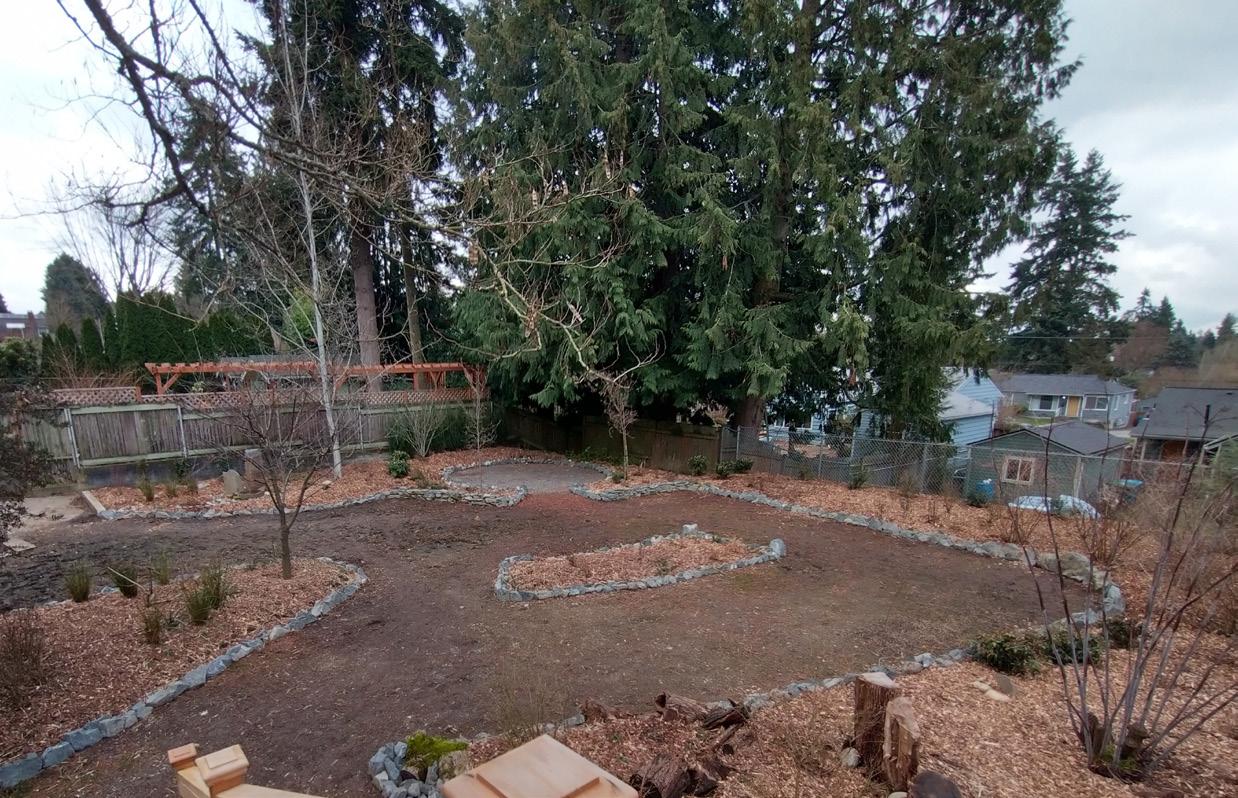

Reduce the area of the city experiencing urban heat island impacts 25% by 2030 and 50% by 2050
In 2022, 5.9% of the city experienced moderate-high urban heat island impacts.*
⟶ Learn more about urban heat islands and their impacts.
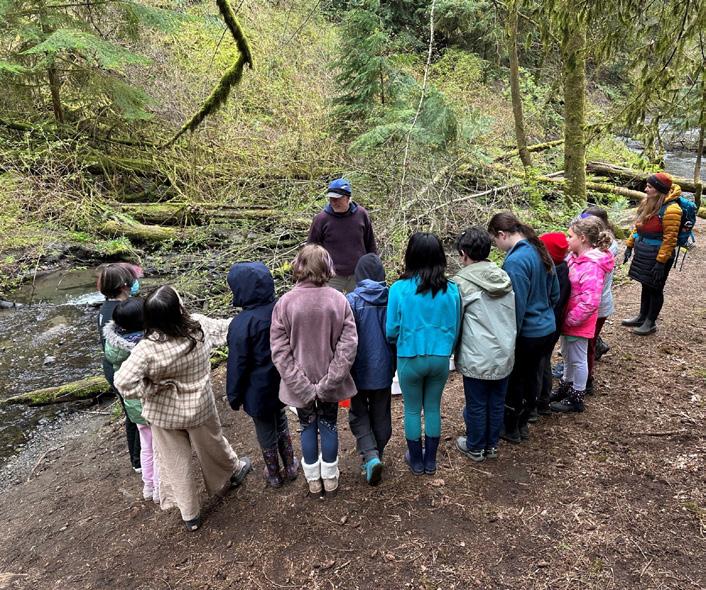
Increase the number of projects that support climate education and awareness biennially
We increased the number of projects we supported from 12 in 2021 to 13 in 2023.
Reduce the 5-year average number of structural flooding occurrences from public sources for storm events up to a 25-year, 24-hour storm
The 5-year average† for any storms of ≤ 25-year magnitude is
12.8
Invest $150,000 for climate awareness and community-based mitigation projects by 2030

$64,003 awarded since 2021
Increase the availability of emergency preparedness materials and trainings to the public by 50% by 2030
We onboarded and trained 15 Community Emergency Response Team (CERT) volunteers, held two CERT meetings, and participated in two outreach events to share emergency preparedness information.†
Incorporate emergency preparedness and climate resiliency planning into 95% of our city plans and codes by 2035 of city codes and plans included emergency preparedness and climate resiliency principles in 2023.† 5%
Update the Hazard Mitigation Plan every 5 years to continue to build upon climate adaptation and resilience strategies and best practices
We last updated our Hazard Mitigation Plan in 2020. We will update the plan again in 2025.

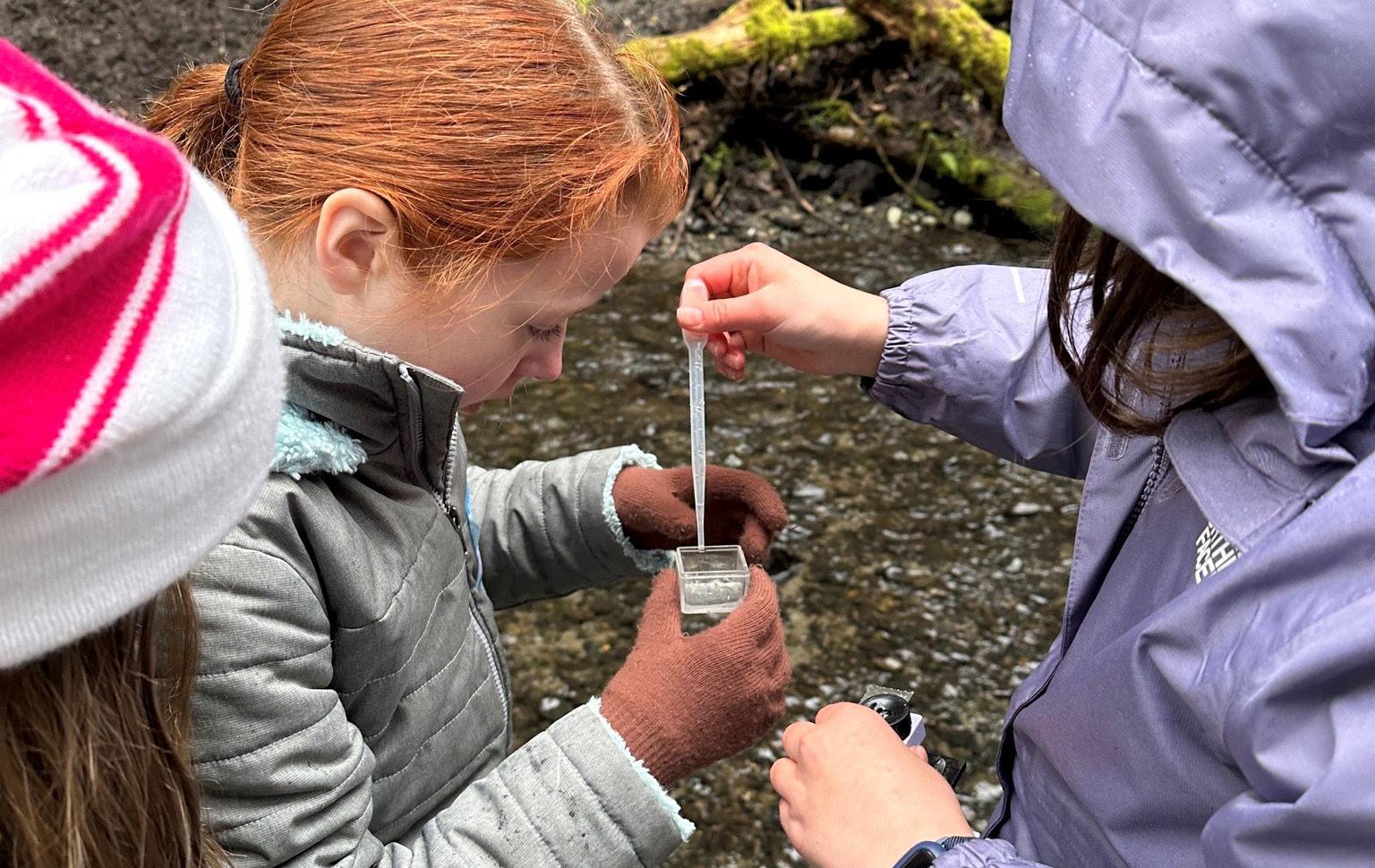

Actions CRP 3.1: Provide mini-grants for community climate projects; CRP 3.2: Provide community education on climate action
Through our Environmental Mini-Grant program, we gave over $10,000 to support six community-driven projects. The projects restored local ecosystems, reduced waste, and provided environmental education for elementary school students and the community.
We also updated our guidelines for the Environmental Mini-Grant program. We now prioritize funding projects that align more closely with our Climate Action Plan targets and strategies.
Action CRP 1.5: Community “nature-scaping” education
We partnered with King County Master Gardeners to host summer gardening workshops for nearly 100 Shoreline residents. The workshops stressed the importance of natural yard care. This includes minimizing and eventually eliminating the use of pesticides, herbicides, and other chemicals.
We also hosted a workshop that provided 16 residents with one-on-one technical assistance to design native landscapes and rain gardens using natural yard care principles.
• Identify options to expand the Soak It Up rebate program in the Surface Water Master Plan update
Action CRP 1.4: Increase incentives for resilience retrofits
• Continue to train and meet with Community Emergency Response Team volunteers and share emergency preparedness resources at related events
Action CRP 2.1: Provide preparedness resources for heat, wildfire smoke, and flooding events)
• Support a new North King County Severe Weather Shelter, led by the King County Regional Homelessness Authority (KCRHA) and the cities of Shoreline, Lake Forest Park, Kenmore, Bothell, and Woodinville.
Action CRP 2.6: Increase shelter and housing services

